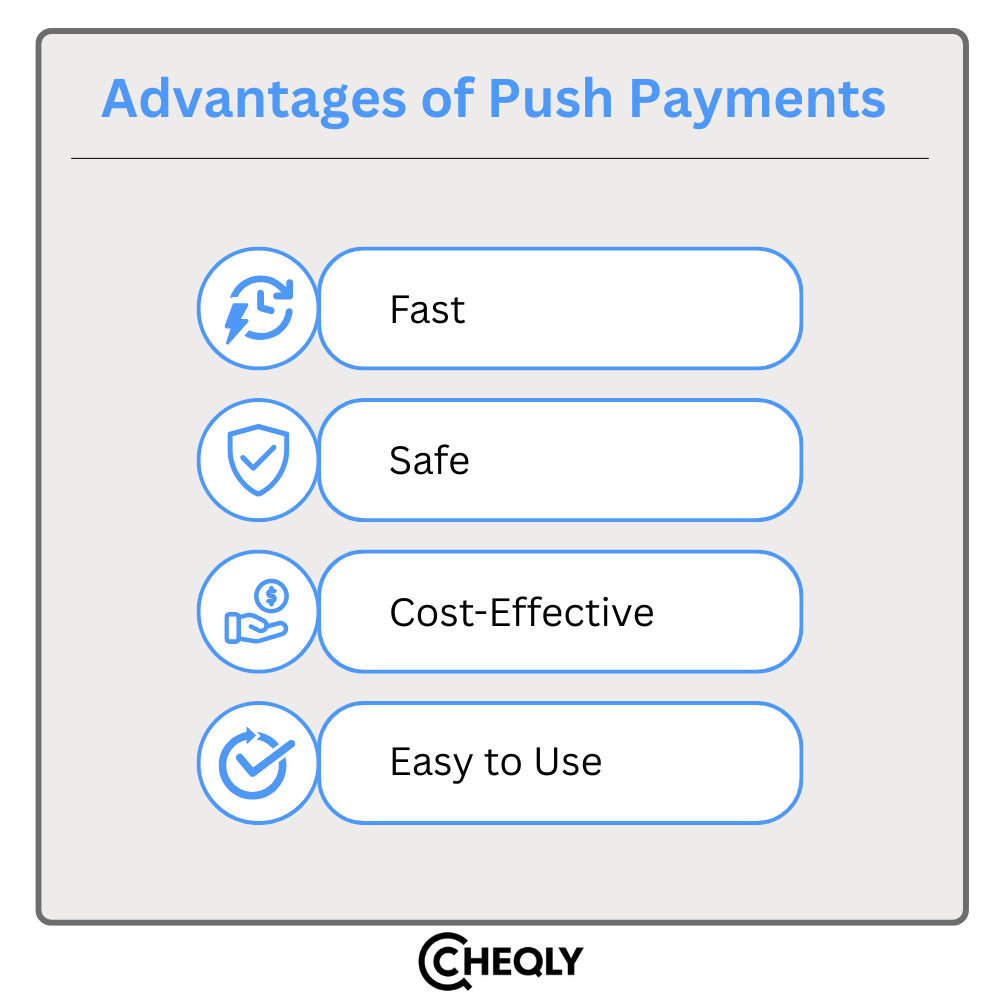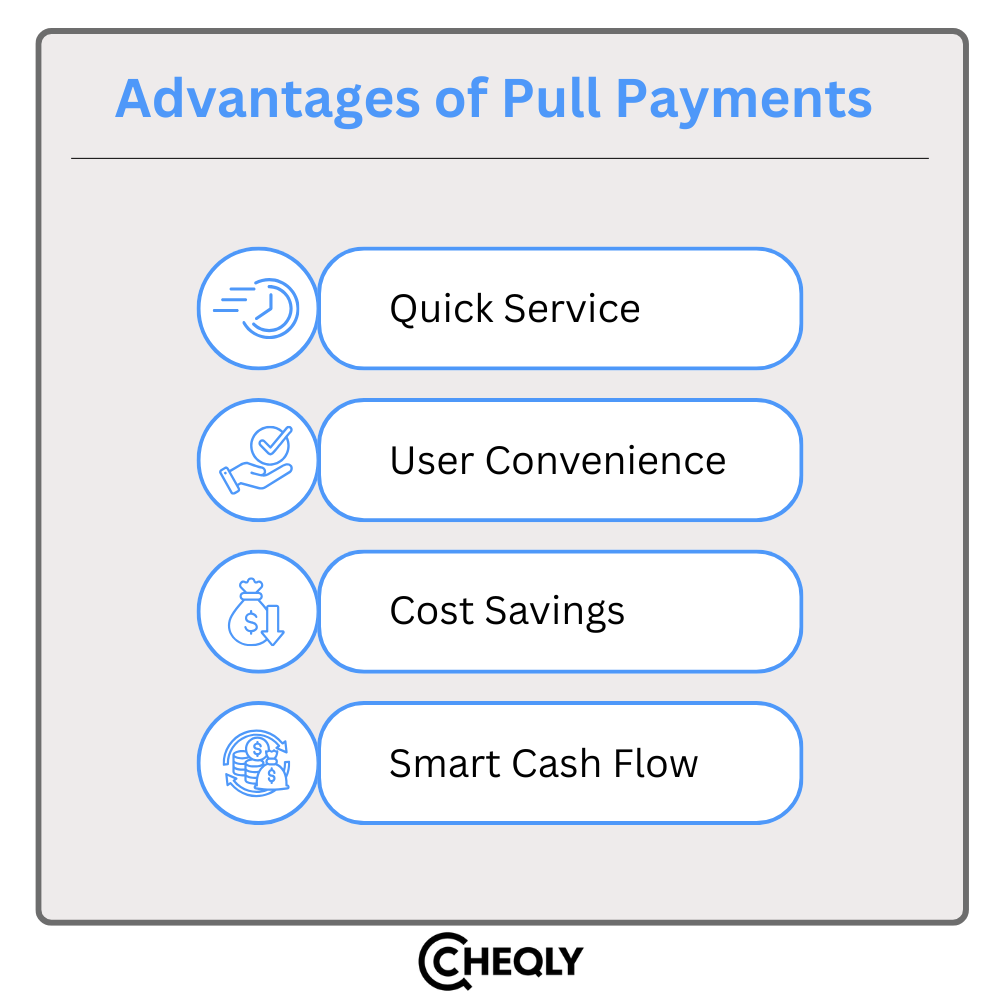One of the common challenges for small business owners and entrepreneurs is choosing the right payment methods to maintain stable cash flow, minimize risk, and ensure customer convenience. Modern payment technology primarily operates through two methods: push payments and pull payments.
In this article, let’s explore push and pull payment methods, their advantages and disadvantages, and real-life situations to better understand when they should be used.
Key Takeaways
- Push payments are under the control of a payer, who can decide when to make a payment (checks, digital wallets, bank transfers).
- Pull Payments are generally those carried out by the payee with the payer’s consent in advance, for example, in the case of subscriptions or recurring bills.
- Push payments can also be quicker since the paying party initiates the transaction as soon as possible, but pull payments might be delayed as scheduled withdrawals are in process.
What is a push payment?
Push payments refer to payment transactions carried out by the person sending the money (the payer). This implies that the payer is usually able to decide the amount of money to be sent, the time at which the payment is made, and the place to which the money is transferred.
How Push Payments Work
Here’s how the process typically works:
- By providing the amount, the recipient (payee), and the account information required for the transfer, the payer starts the payment process.
- The payment money is taken out of the payer’s account by the financial institution or payment service provider after authorization.
- The payer’s financial institution sends funds to the payee’s banking institution.
- The banking institution credits the payee’s account.
- Account history updates, notifications, or messaging services are used to confirm the successful transfer for both account holders.
Depending on the service provider and the kind of transfer, push payments can be processed quickly or take one to three business days or longer. Before the transaction is finished, the payer has the option to halt or modify it.
What are pull payments?
A method where the customer gives a business the right to withdraw money on a regular basis. The business has the authority to decide the amount, date, and frequency after receiving authorization.
How Pull Payments Work
This is how they operate:
- After receiving authorization from the payer, the payee produces a payment instruction using the amount and the bank account location (routing and account number).
- The payee starts the transaction by sending it to the payer’s bank, either directly or through a third-party payment service.
- The money is taken out of the payer’s account by the payer’s bank.
- Funds are sent to the payee’s banking institution from the payer’s financial institution.
- Their banking institution credits the payee’s account.
- Account history updates, notifications, or messaging services are used to confirm the successful transfer for both account holders.
Settlements for pull payments could be completed within 1–3 working days; however, some are immediate. Customers are able to cancel if they remove the authorization no later than three days before the payment.
Push payment examples
The payer starts pushing payments from their bank accounts or linked services. They grant authority over the timing and mode of payment. Among the examples are:
- Transferring between bank accounts: Transferring funds between two linked checking accounts at the same bank or another financial institution.
- Use Digital Wallets: Using a friend or family member’s digital wallet (such as PayPal or Apple Pay) to divide a bill or assist with expenses.
- Send Money via Peer-to-Peer Services: Sending money for a purchase or gift using a peer-to-peer (P2P) platform such as Venmo or Cash App.
- Receive Government Payments: A monthly child support payment or retirement benefit is sent straight to a customer’s bank account by a government agency via direct deposit.
- Gig Worker Payouts: A fintech business pays gig workers their wages directly to their debit cards.
Pull payment examples
Pull payments function by letting the payee initiate the transaction, but they still require the payer’s authorization and account details. An illustration would be a consumer going to the website of their power provider, entering their account numbers and routing information, and consenting to a debit. The payee runs the procedure and starts the payment on the agreed date, even if the payer must opt in. Pull payments include the following:
- Direct Debits from a bank account: Direct withdrawals from a bank account to pay taxes, a mortgage, an automobile payment, or an electricity bill.
- Automated credit card payments: Credit card payments that are automatically made for services like pet food delivery, gym memberships, and streaming movie subscriptions.
- Automated clearing house (ACH) debits: Businesses utilize Automated Clearing House (ACH) debits for payroll services, ensuring workers receive their payments.
- Digital wallets: Digital wallets that use funds from a linked bank account to cover prearranged transactions.
Advantages of Push Payments
Consumers and businesses have found the use of push payments to be more efficient in conducting transactions that were traditionally completed through paper checks.

Fast
Depending on the regulations of the banking institutions, push payments may take several business days. This is still much faster than other payment methods, such as money orders or checks, which can take days or weeks to get, send, and clear.
Because instant payment technology reconciles the bank’s information in real-time, push payments can sometimes be completed in a matter of minutes.
Safe
The participating institutions process payments, giving payers discretion over who and how they send money. Two payment methods that are push-only due to their security characteristics are FedNow and RTP.
Push payments go through verification and encryption procedures that make them less vulnerable to fraud attempts than more manual payment methods like checks or money orders. The payer has the option to cancel the payment before it is processed if they have any concerns.
Cost-Effective
The typical consumer cannot afford to use electronic payment methods like wire transfers regularly due to their high charge structures. Even though push payments include fees, they might be much less if the payer chooses the slower processing options.
Push payments also offer a cost-effective alternative to mailing checks or money orders via the fastest tracked or insured mail service because there are no postage costs.
Easy to Use
Push payments don’t require going to a bank; they can be initiated from a computer or smartphone and happen quickly. These fast payments simplify tasks such as paying back a friend or splitting a restaurant check.
Additionally, they offer round-the-clock services, including paying a rent bill at any time of day or night, even on weekends and holidays. Push payments help people manage their lives and maintain financial control in an increasingly digitalized environment.
Advantages of Pull Payments
Pull payments further enable payers to have a wider range of choices in managing their personal and professional finances. They share the same advantages but with some different uses, since they are employed in recurring payment situations where providing the payee with additional control is likely to be more advantageous.

Quick Service
Pull payments can be instantaneous for individuals who require immediate access to funds, although they often occur within one to three business days. For instance, wholesalers or merchants require a down payment to ship products, particularly to startups.
Compared to a check or payment initiated by the business, pull payment authorizations for large down payments to secure inventory can help these new enterprises transfer cash instantly and get things underway with minimal delay.
User Convenience
Certain vendors, such as cellphone carriers, might go as far as to offer special prices for recurring pull payment agreements, while businesses not only value the administrative ease of pull payments but also find them well-suited for business activities such as issuing invoices and payment reconciliation. These payments function effectively in an automated financial system, which is becoming prevalent with modern accounting and bookkeeping software.
Cost Savings
Customers are less likely to incur late fees for failing to pay their bills when automatic payments are configured to process in advance. Customers save money as a result, but businesses are also able to collect payments more readily and without using costly collection techniques.
Since pull payments have lower fees than most credit card processors, businesses also save money over time.
Smart Cash Flow
Businesses that use pull payments are able to predict a certain amount of income each payment cycle. Cash flow reports and other long-term corporate planning projects benefit from this.
Pending pull payments may raise a company’s value and be a positive indication for investors, as they can be considered short-term, recoverable accounts receivable.
To conclude, both push and pull payments have advantages and disadvantages. The appropriate method to use is one that best suits your business, as it has a direct impact on cash flow, productivity, and customer experience.
FAQs: Push Payments vs. Pull Payments
Here are some common questions about push and pull payments:
Do both payment types support tracking?
Yes. Modern systems, most notably the digital ones, have enabled real-time tracking and notifications for both push and pull payments.
Can pull payments be automated?
Yes, several pull payments, such as subscriptions or bills, are done automatically after setting up.
Can a business use both methods?
Definitely, a lot of companies are using push for payments and pull for collections.
Do banks charge differently for each method?
Yes, charges are different for wire transfers, ACH pulls, or card-based pull transactions.
Do banks charge more for push or pull?
A push payment (for example, a wire transfer) generally incurs more charges than a pull payment (for example, ACH).
Can push payments be reversed?
Push payments, such as wire transfers, are generally not reversible, whereas pull payments may be subject to disputes if unauthorized or incorrect.
Can push payments be scheduled?
Yes, payments made using push can be scheduled for a certain date or can also be set up to repeat.
Experience Frictionless Domestic Payments with Cheqly
Managing payments is a major aspect of doing business, and Cheqly certainly simplifies it. Domestic payments via ACH transfers allow you to send money anywhere in the US at no cost. It doesn’t matter if you are making payments to vendors, contractors, or transferring money between your business accounts—Cheqly makes the process smooth, and it also offers live tracking as a feature.
Open a Cheqly business account and simplify your domestic payments.
